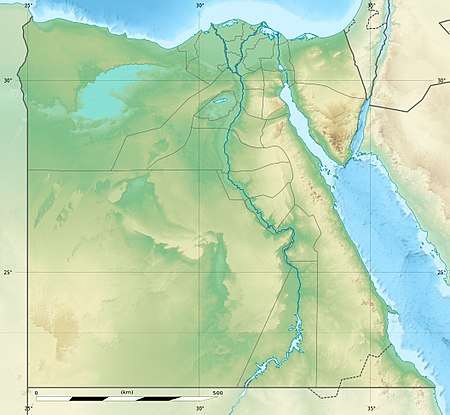Pyramid of Senusret II
| Pyramid of Senusret II | ||||||||||||||
|---|---|---|---|---|---|---|---|---|---|---|---|---|---|---|
|
Pyramid of Senusret II at el-Lahun | ||||||||||||||
| Senusret II | ||||||||||||||
| Coordinates | 29°14′N 30°58′E / 29.233°N 30.967°ECoordinates: 29°14′N 30°58′E / 29.233°N 30.967°E[1] | |||||||||||||
| Ancient name |
Ḫˁ Sn-wsr-t Xa Sen-user-et "Senusret shines"[2] | |||||||||||||
| Constructed | Twelfth Dynasty | |||||||||||||
| Material | Mudbrick[3] | |||||||||||||
| Height |
48.65 m (159.6 ft; 92.84 cu)[4] or 47.6 m (156 ft; 90.8 cu)[3] | |||||||||||||
| Base |
107 m (351 ft; 204 cu)[4] or 106 m (348 ft; 202 cu)[3] | |||||||||||||
| Slope | 42°35'[3] | |||||||||||||
 Location within Egypt | ||||||||||||||
The Pyramid of Senusret II, also spelled Pyramid of Senwosret II,[3] is the pyramid complex constructed for the pharaoh Senusret II in the Twelfth Dynasty.[lower-alpha 1][8][11]
Location and early excavation
Karl Richard Lepsius visited the pyramid in the 1840s and conducted a brief archaeological survey of the site.[2] Fifty years later, Flinders Petrie conducted the first comprehensive excavations there.[2] Petrie spent several unsuccessful months searching for the entrance into the pyramid on the north face of the pyramid.[2][3] Senusret II had, however, taken a complete departure from the usual practice of having a corridor on the north side, – typical of Old Kingdom and early Middle Kingdom pyramids[2] – and had instead built a narrow, vertical entrance shaft under a princess' tomb located about a dozen yards off to east of the southern pyramid face.[12][3] The Czech Egyptologist Miroslav Verner explains that the decision had been made for a combination of religious reasons, and to thwart grave robbers.[2] The builders had even constructed the usual small chapel on the north face, which typically concealed the entrance.[2] Petrie did eventually find the entrance, after many months and multiple failed attempts.[13]
A small team headed by N. B. Millet of the Royal Ontario Museum and the architect J. E. Knudstad has been working at the site of the pyramid town and pyramid since 1989.[8] Their goal is to expand on Petrie's work by re-gathering architectural details of the monuments there, which Petrie had neglected to record in his reports.[8]
Mortuary complex
Main pyramid
The core of the pyramid was constructed from mudbrick around a stump of four steps of yellow limestone.[3][14] The builders utilized a rock outcropping to anchor the pyramid and reduce construction time and cost.[14] The completed pyramid was originally encased in white limestone, though an inscription found by Petrie indicates that the casing was removed in the Nineteenth Dynasty for reuse in a different structure built by Ramesses II.[14] Only remnants of the black granite pyramidion, which topped the pyramid, have been found.[14]
The pyramid was protected from flooding by a trench surrounding the perimeter of the pyramid and filled with sand to absorb rainwater.[3][14] Cut into the rock was a stone wall with deep niches.[14]
Notes
References
- ↑ Hölzl 1999, p. 516.
- 1 2 3 4 5 6 7 8 Verner 2001e, p. 409.
- 1 2 3 4 5 6 7 8 9 Lehner 2008, p. 175.
- 1 2 Verner 2001e, p. 465.
- ↑ Dodson & Hilton 2004, p. 289.
- ↑ Lehner 2008, p. 8.
- ↑ Arnold 2003, p. 267.
- 1 2 3 4 Frey 2001, p. 150.
- ↑ Grimal 1992, p. 391.
- ↑ Shaw 2004, p. 483.
- ↑ Simpson 2001, p. 455.
- ↑ Verner 2001e, pp. 409–410.
- ↑ Verner 2001e, p. 420.
- 1 2 3 4 5 6 Verner 2001e, p. 410.
Sources
- Arnold, Dieter (2003). The Encyclopaedia of Ancient Egyptian Architecture. London: I.B Tauris & Co Ltd. ISBN 978-1-86064-465-8.
- Dodson, Aidan; Hilton, Dyan (2004). The Complete Royal Families of Ancient Egypt. London: Thames & Hudson. ISBN 978-0-500-05128-3.
- Frey, Rosa A. (2001). "Illahun". In Redford, Donald B. The Oxford Encyclopedia of Ancient Egypt, Volume 2. Oxford: Oxford University Press. pp. 150–151. ISBN 978-0-19-510234-5.
- Grimal, Nicolas (1992). A History of Ancient Egypt. Translated by Ian Shaw. Oxford: Blackwell publishing. ISBN 978-0-631-19396-8.
- Hölzl, Christian (1999). "Lahun, pyramid complex of Senusret II". In Bard, Kathryn. Encyclopedia of the archaeology of ancient Egypt. London; New York: Routledge. pp. 516–517. ISBN 978-0-203-98283-9.
- Lehner, Mark (2008). The Complete Pyramids. New York: Thames & Hudson. ISBN 978-0-500-28547-3.
- Shaw, Ian, ed. (2004). The Oxford History of Ancient Egypt. Oxford: Oxford University Press. ISBN 978-0-19-815034-3.
- Simpson, William Kelly (2001). "Twelfth Dynasty". In Redford, Donald B. The Oxford Encyclopedia of Ancient Egypt, Volume 3. Oxford: Oxford University Press. pp. 453–457. ISBN 978-0-19-510234-5.
- Verner, Miroslav (2001e). The Pyramids: The Mystery, Culture and Science of Egypt's Great Monuments. New York: Grove Press. ISBN 978-0-8021-1703-8.
Excavation reports
- William Matthew Flinders Petrie: Illahun, Kahun and Gurob. 1889–1890. Nutt, London 1891 (Onlineversion).
- William Matthew Flinders Petrie, Guy Brunton, Margaret Alice Murray: Lahun II. British School of Archaeology in Egypt and Bernard Quaritch, London 1923 (PDF; 12,9 MB).
| Wikimedia Commons has media related to Pyramid of Senusret II. |